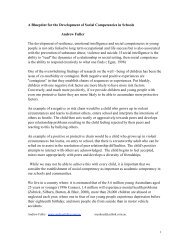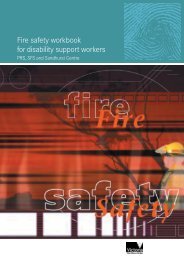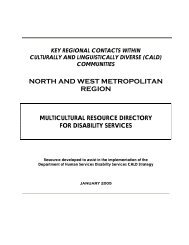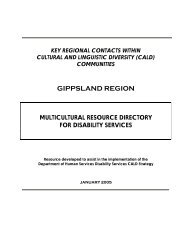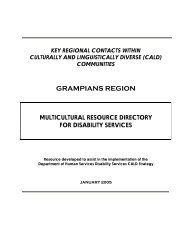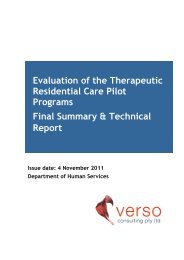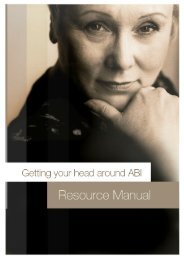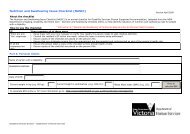Positive Behaviour Support - Department of Human Services - Vic ...
Positive Behaviour Support - Department of Human Services - Vic ...
Positive Behaviour Support - Department of Human Services - Vic ...
Create successful ePaper yourself
Turn your PDF publications into a flip-book with our unique Google optimized e-Paper software.
60 <strong>Positive</strong> behaviour support: Getting it right from the start - Facilitators reference manual<br />
PowerPoint 84<br />
PowerPoint 85<br />
*<br />
*<br />
Step 2: What happens, before, during and after the behaviour?<br />
Now that we know what the behaviour is, we need to gather as much information as possible<br />
about the behaviour.<br />
• What happens before the behaviour? (Setting events: triggers and warning signs)<br />
• What happens during the behaviour? (Action: What did the person actually do? What did it<br />
look like?)<br />
• What happens after the behaviour? (Results: What is the person getting from the behaviour?)<br />
It is not necessary here to be able to identify exactly what triggered the incident. This is<br />
sometimes difficult. Our task is to take careful note <strong>of</strong> relevant events that preceded the episode.<br />
By doing this we will <strong>of</strong>ten be able to uncover patterns in the behaviour. As mentioned earlier,<br />
behaviour is <strong>of</strong>ten predictable: that is if A happens B will follow.<br />
Setting events, triggers and warning signs<br />
In identifying setting events it is important to consider possible background factors. What was<br />
happening in the environment? Where did the behaviour occur? Who was there at the time?<br />
General setting events<br />
The following events may influence whether the behaviour occurs.<br />
Factors external to the person<br />
• Staff changes<br />
• Level <strong>of</strong> structure in the<br />
environment<br />
• Activity levels in the environment<br />
• Level <strong>of</strong> stress or tension in the<br />
environment<br />
• Isolation<br />
• Noise levels.<br />
Action<br />
Factors internal to the individual<br />
• Pain<br />
• Hunger<br />
• Stress<br />
• Tension<br />
• Depression<br />
• Tiredness<br />
• Frustration<br />
• Medical factors (medical<br />
conditions, medication and<br />
side effects).<br />
Warning signs that the<br />
individual displays to indicate<br />
that something is not quite right<br />
• Person withdraws<br />
• Repetitive questioning<br />
• Facial expression changes<br />
• Mood changes<br />
• Pacing<br />
• Over activeness<br />
• Difficulty attending to task.<br />
Describing what the person actually did? What did the behaviour look like?<br />
Examples:<br />
• Person used left fist to hit co-resident Mary on the head twice.<br />
• Banged back <strong>of</strong> head on wall five times.<br />
• Picked up television with both hands and threw it towards the window. The window did<br />
not break.<br />
• Person picked up chair with both hands and threw it across the kitchen towards staff member.<br />
Results: Identifying the result or outcome is about developing an understanding <strong>of</strong> what the<br />
person is getting from the behaviour that motivates them to do it again and again that is what<br />
happens following the behaviour that achieves an important result for the person.



